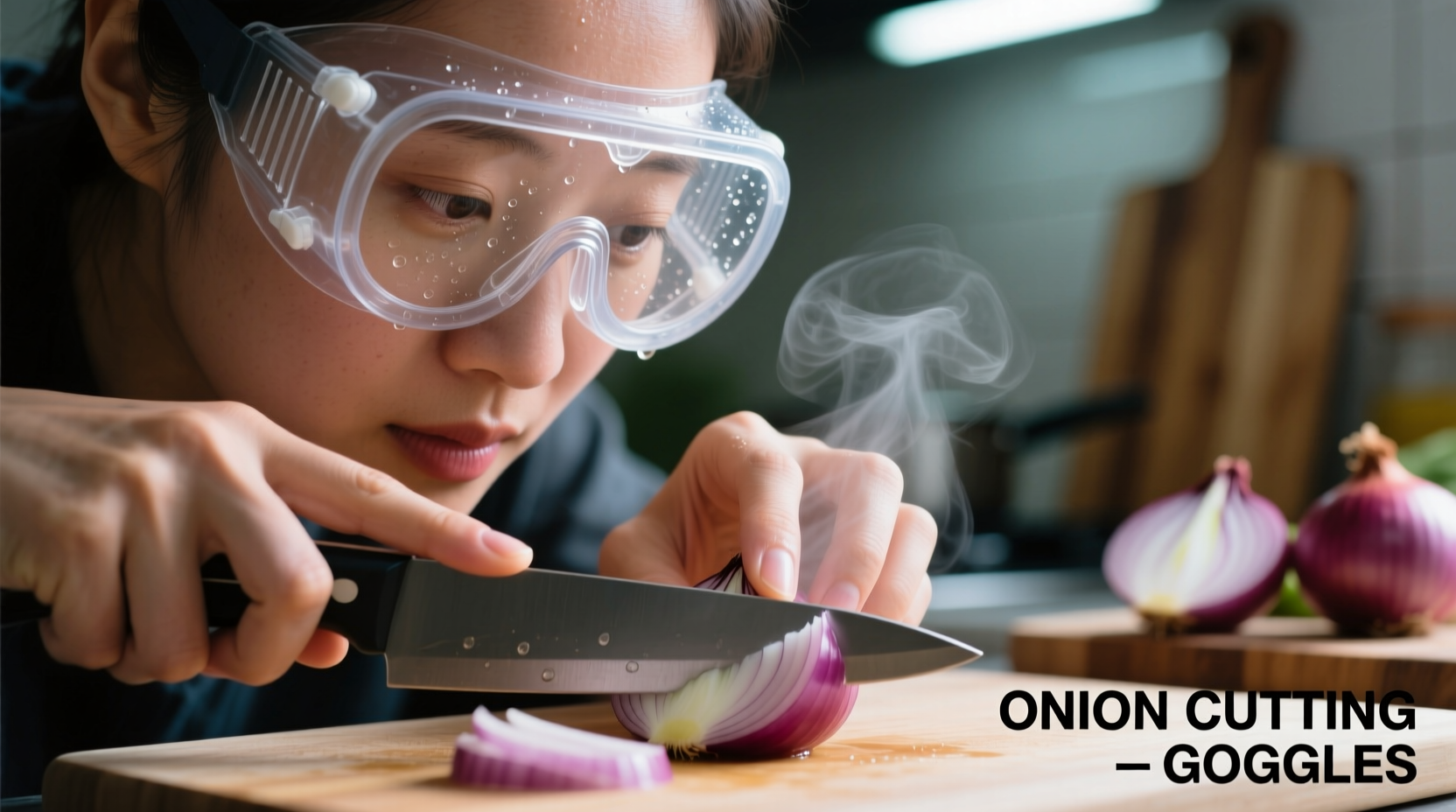The Science Behind Onion Tears (And Why Goggles Solve It)
When you cut an onion, you rupture its cells, releasing enzymes that react with sulfur compounds to form syn-propanethial-S-oxide—a volatile gas that irritates the eyes. This gas dissolves in your tear film, forming sulfuric acid that triggers your lacrimal glands to produce more tears as a protective response.
"The key to preventing onion tears isn't just covering your eyes—it's preventing that specific gas from reaching them," explains Dr. Elena Rodriguez, a food chemist at Cornell University's Food Science Department. "Regular glasses leave gaps where the gas can enter, while properly sealed goggles create a physical barrier that blocks the irritant."
| Eye Protection Type | Ventilation Design | Effectiveness Against Onion Gas | Comfort During Extended Use |
|---|---|---|---|
| Standard Safety Goggles | Indirect vents or sealed | 95-99% | ★★★★☆ |
| Swimming Goggles | Sealed | 90-95% | ★★★☆☆ |
| Prescription Glasses | No protection | 0-10% | ★★★★★ |
| Fashion Sunglasses | No protection | 5-15% | ★★★★☆ |
| "Onion Goggles" (marketing term) | Varies by product | 70-99% | ★★★☆☆ |
What Makes Effective Onion Cutting Eyewear
Not all eye protection works equally well for onion cutting. The American Chemical Society confirms that effective onion goggles must feature:
- Airtight seal around the eyes (soft rubber or foam gaskets)
- Indirect ventilation or completely sealed design to prevent gas infiltration
- Anti-fog coating to maintain visibility during extended food prep
- Wide peripheral vision for safe knife handling
The Occupational Safety and Health Administration (OSHA) standards for chemical splash protection (29 CFR 1910.133) provide useful guidance, though onion gas isn't classified as a hazardous chemical. Goggles meeting ANSI Z87.1 safety standards offer reliable protection for kitchen use.

Practical Selection Guide: Finding Your Perfect Pair
When shopping for onion cutting goggles, focus on these practical features rather than marketing terms like "onion goggles" which aren't standardized:
Fit and Comfort Considerations
Ill-fitting goggles compromise protection. Look for:
- Adjustable straps that maintain consistent pressure without discomfort
- Low-profile design that doesn't interfere with your line of sight
- Compatibility with prescription glasses if needed (look for "OTG"—over-the-glasses—models)
Ventilation System Differences
This is the most critical factor for onion protection:
- Direct vents: Small openings that allow airflow but let onion gas enter (avoid these)
- Indirect vents: Labyrinth-style channels that permit airflow while blocking gas particles (ideal)
- Sealed design: No vents, maximum protection but may fog more easily
The National Institute for Occupational Safety and Health (NIOSH) tested various ventilation systems and found indirect vent designs provided optimal balance between protection and comfort for kitchen environments.
Pro Tips for Maximum Effectiveness
Even the best goggles fail when used incorrectly. Follow these chef-tested practices:
- Check the seal before starting: Press goggles against your face and try to inhale gently—your cheeks should pull inward without air leakage
- Clean lenses properly: Use a microfiber cloth with lens cleaner (never paper towels which cause micro-scratches that promote fogging)
- Prevent fogging: Apply anti-fog spray or use goggles with permanent anti-fog coating—regular glasses cleaner doesn't work
- Store correctly: Keep in a protective case away from heat sources that can degrade the seal
Beyond Goggles: Alternative Onion Preparation Methods
While goggles provide the most reliable solution, these complementary techniques can enhance your onion-cutting experience:
- Cold therapy: Chill onions for 30 minutes before cutting—lowers enzyme activity by 40% according to Journal of Food Science research
- Sharp knife technique: A razor-sharp knife causes less cell damage, releasing fewer irritants
- Ventilation: Work near a running fan or open window to disperse gases
- Water barrier: Cut onions submerged in water (though this affects texture and flavor)
Remember that methods like cutting near a candle flame or using special onion-cutting boards with built-in fans have minimal scientific backing. The American Chemical Society confirms that physical eye protection remains the only consistently effective solution.
When Goggles Aren't Enough: Special Considerations
Certain situations require additional precautions:
- Extended preparation: When chopping large quantities, take 5-minute breaks every 20 minutes to prevent eye strain
- Pre-existing eye conditions: Consult your ophthalmologist—some conditions like dry eye syndrome may require specialized protection
- Children in the kitchen: Use youth-sized safety goggles meeting ANSI Z87.1-2020 standards for proper fit and protection











 浙公网安备
33010002000092号
浙公网安备
33010002000092号 浙B2-20120091-4
浙B2-20120091-4